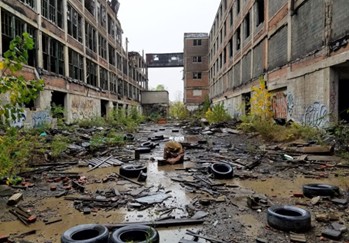Building a new subdivision is complicated. Almost every city and county in America have master plans dictating “conforming uses” of land. Most specify lot and home sizes, rules for vehicle access, water supply, sewage disposal, flood control, affordable housing, and park space. Those are addressed in lengthy application processes and public hearings, all preceding building the infrastructure, and then the homes.
The National Association of Home Builders says government regulations account for 24 percent of the final price of new homes. Sixty percent of that comes during planning and development, only 40 percent during actual construction. Those costs are many times higher when building businesses or industries. So, how much cheaper would homes and businesses be if the builder did not have to pay for streets, sidewalks, electricity, water and sewer, or drainage? What if they built where that infrastructure already existed?
There are dilapidated old sites and empty lots in every city in the U.S., where the required infrastructure is already there. Most large cities have square miles of such places. Yet development continues to sprawl ever further from the cities, gobbling up farmland like Pac-Man instead of redeveloping inner cities, despite decades of talk, debate, and controversy about preserving open space.
Urban sprawl is a serious problem in U.S. cities. It threatens productive agricultural areas, causes longer commutes, burns more gasoline, and causes more air pollution. Inner cities further decay, consuming more natural resources in less efficient ways. Thus, natural resources policy has long been influenced by concerns about sprawl and how to stop it, including encouraging developers to build on these older properties in the cities. These areas are called “brownfields” and there are hundreds of projects designed to redevelop them.
An association of state-level natural resources department secretaries, of which I was president 20 years ago, mounted a campaign for brownfield projects, led by John Oliver, the first Secretary of Pennsylvania’s Department of Conservation and Natural Resources. His leadership highlighted urban redevelopment projects that were models for state-federal collaboration. Yet in nearly every city, urban sprawl remains a serious issue and brownfield projects have scarcely made a dent. Why?
It is at least partly because the federal government has complicated the issue. Business decisions, such as where to build new housing or commercial developments, are based on costs and profits, plain and simple. So, why isn’t it cheaper and more profitable to build where the infrastructure already exists? It would be, except for the regulatory nightmare that goes with previously developed sites, because someone in the past might have spilled something bad on the ground. That means not only local rules but also federal regulations. There are over 425,000 brownfield sites across the U.S. where hazardous substances, pollutants, and contaminants are said to be found – and that deprives local communities of these economic development opportunities. Many of these sites are now under EPA’s “brownfield redevelopment initiative” and some are “Superfund” sites. In other words, the initiative has been hijacked by federal agencies, forcing many local governments to wash their hands of it. Brownfields are now an underfunded EPA program, not an incentive for redevelopment.
If left to state and local governments, redevelopment would be less onerous. Two decades ago, led by Governor Bill Owens, Colorado even authorized tax credits to offset the costs of cleaning up old sites, so brownfields could be redeveloped more quickly and profitably, revitalizing downtowns and preserving outlying open spaces, farms and ranches. But federal interference still hinders the process.
My friend Jim Connaughton, a technology entrepreneur, policy expert, and innovation infrastructure developer who formerly chaired the White House Council on Environmental Quality, is a world-class authority on brownfields. He recently testified, before the House Subcommittee on Environment, that the federal permitting process must be reformed if Congress is serious about brownfield redevelopment.
“Growing our economy to meet the needs of a thriving population and national security will require a doubling or tripling of infrastructure over the next 25 years… hundreds of thousands of new projects.” Yet the “speed bump” he identified is: agency delays in approving site assessments, followed by years of the environmental permitting mess – a process purposely designed to block projects, not enable them. He advocates identifying properties for categorical approval for building – environmental compliance still required but enforced if needed afterwards. He calls it the “ABC” approach – “approve, build, comply,” rather than the reverse.
That’s much smarter than the current system, where developers build on prime farmland and open space, instead of the far more obvious sites.





{ 1 comment… read it below or add one }
Before that would work someone would want a nice new home in old junkie neighborhoods.
Also there is the issue of 3 rd and 4th generation “farmers” who likely have better educations than their parents and have become ”waiters”, waiting to inherit so they can sell the land and go broke on their ancestors work.
Cycles and preferences get in the way of logic as stated.